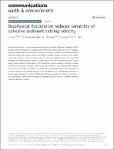Biophysical flocculation reduces variability of cohesive sediment settling velocity
| dc.contributor.author | Ye, L | |
| dc.contributor.author | Penaloza-Giraldo, JA | |
| dc.contributor.author | Manning, Andrew | |
| dc.contributor.author | Holyoke, J | |
| dc.contributor.author | Hsu, T-J | |
| dc.date.accessioned | 2023-05-25T11:32:47Z | |
| dc.date.available | 2023-05-25T11:32:47Z | |
| dc.date.issued | 2023-04-24 | |
| dc.identifier.issn | 2662-4435 | |
| dc.identifier.issn | 2662-4435 | |
| dc.identifier.other | 138 | |
| dc.identifier.uri | https://pearl.plymouth.ac.uk/handle/10026.1/20933 | |
| dc.description.abstract |
Biophysical cohesion, introduced predominantly by Extracellular Polymeric Substances (EPS) during mineral flocculation in subaqueous environments, plays important role in morphodynamics, biogeochemical cycles and ecosystem processes. However, the mechanism of how EPS functioning with cohesive particles and affects settling behaviors remain poorly understood. We measure initial flocculation rate, floc size and settling velocity of mineral and artificial EPS (Xanthan gum) mixtures. Combining results from these and previous studies demonstrate coherent intensification of EPS-related flocculation compare with those of pure mineral and oil-mineral mixtures. Importantly, the presence of EPS fundamentally changes floc structure and reduces variability of settling velocity. Measured data shows that ratios of microfloc and macrofloc settling velocity for pure mineral flocs is 3.9 but greatly reduced to a lowest value of 1.6 due to biological EPS addition. The low variability of settling velocity due to EPS participation explains the seemingly inconsistent results previously observed between field and laboratory studies. | |
| dc.format.extent | 138- | |
| dc.language | en | |
| dc.publisher | Springer Science and Business Media LLC | |
| dc.title | Biophysical flocculation reduces variability of cohesive sediment settling velocity | |
| dc.type | journal-article | |
| dc.type | Journal Article | |
| plymouth.author-url | https://www.webofscience.com/api/gateway?GWVersion=2&SrcApp=PARTNER_APP&SrcAuth=LinksAMR&KeyUT=WOS:000975948500003&DestLinkType=FullRecord&DestApp=ALL_WOS&UsrCustomerID=11bb513d99f797142bcfeffcc58ea008 | |
| plymouth.issue | 1 | |
| plymouth.volume | 4 | |
| plymouth.publication-status | Published online | |
| plymouth.journal | Communications Earth & Environment | |
| dc.identifier.doi | 10.1038/s43247-023-00801-w | |
| plymouth.organisational-group | |Plymouth | |
| plymouth.organisational-group | |Plymouth|Research Groups | |
| plymouth.organisational-group | |Plymouth|Faculty of Science and Engineering | |
| plymouth.organisational-group | |Plymouth|Faculty of Science and Engineering|School of Biological and Marine Sciences | |
| plymouth.organisational-group | |Plymouth|Research Groups|Marine Institute | |
| plymouth.organisational-group | |Plymouth|REF 2021 Researchers by UoA | |
| plymouth.organisational-group | |Plymouth|Users by role | |
| plymouth.organisational-group | |Plymouth|Users by role|Academics | |
| plymouth.organisational-group | |Plymouth|REF 2021 Researchers by UoA|UoA07 Earth Systems and Environmental Sciences | |
| dcterms.dateAccepted | 2023-04-12 | |
| dc.date.updated | 2023-05-25T11:32:41Z | |
| dc.rights.embargodate | 2023-5-26 | |
| dc.identifier.eissn | 2662-4435 | |
| dc.rights.embargoperiod | forever | |
| rioxxterms.versionofrecord | 10.1038/s43247-023-00801-w |


